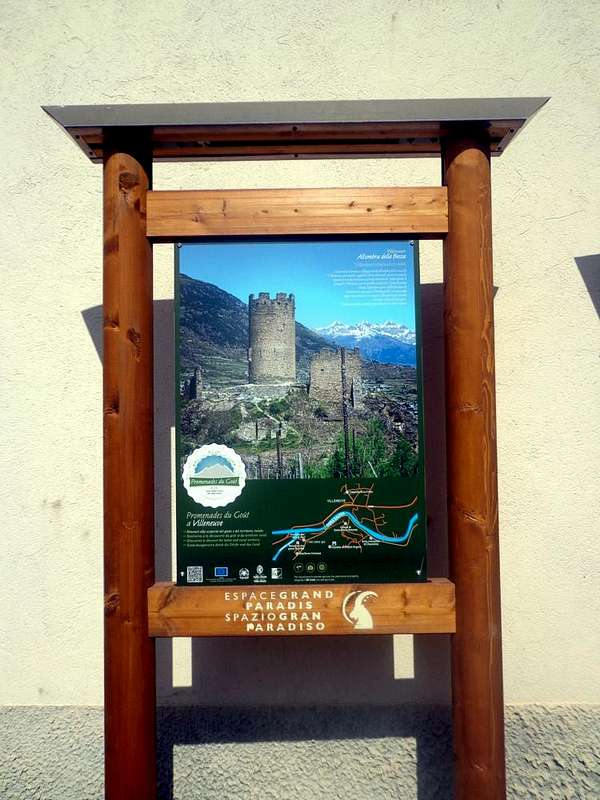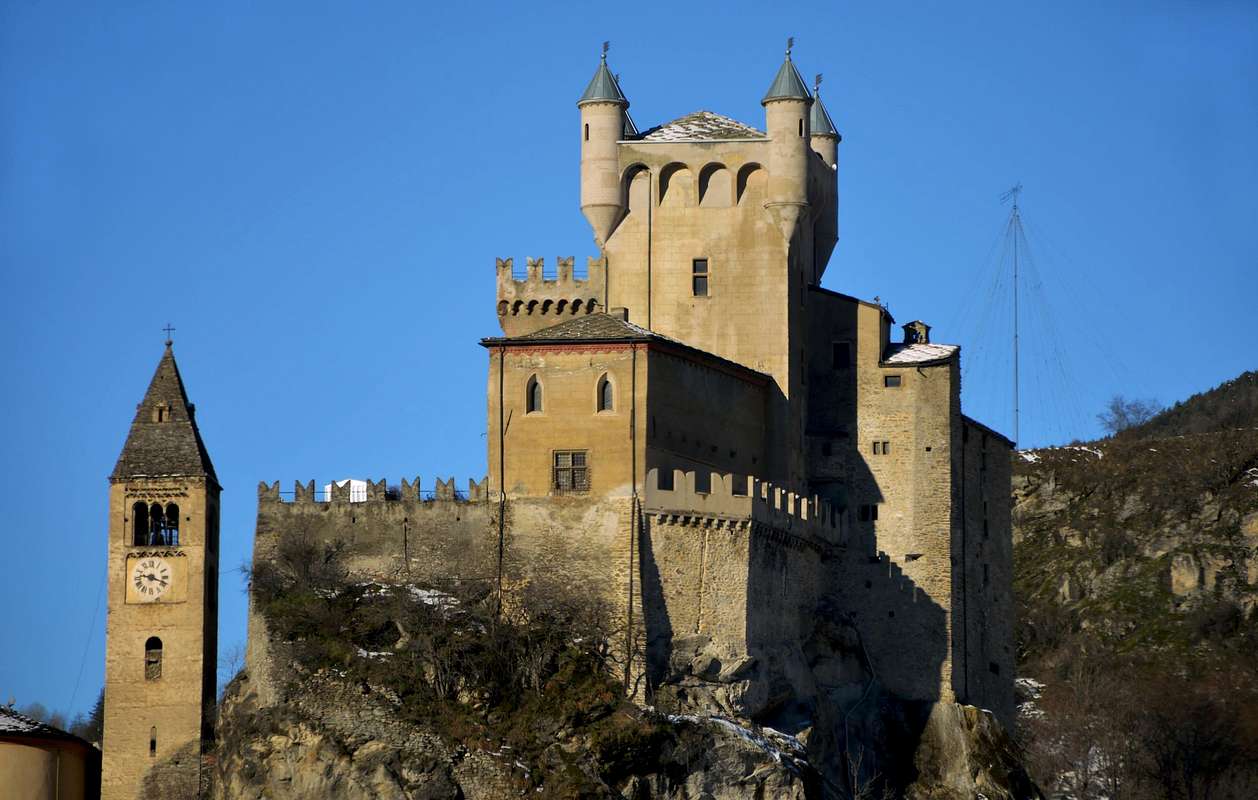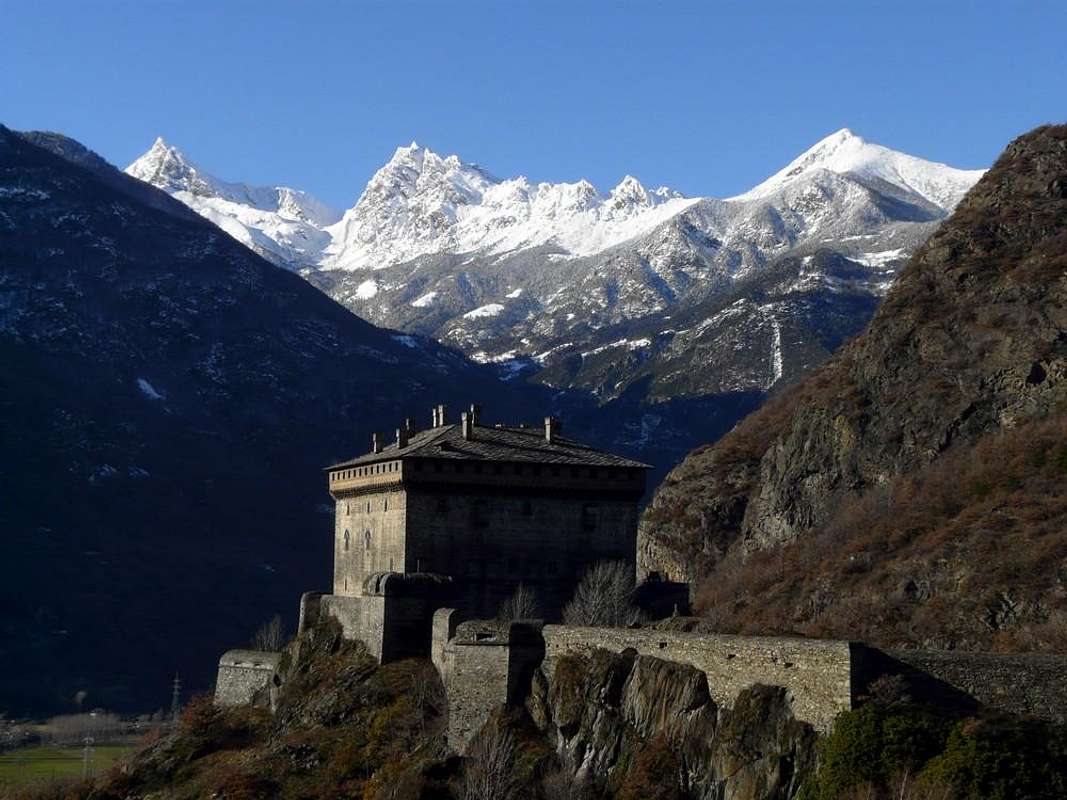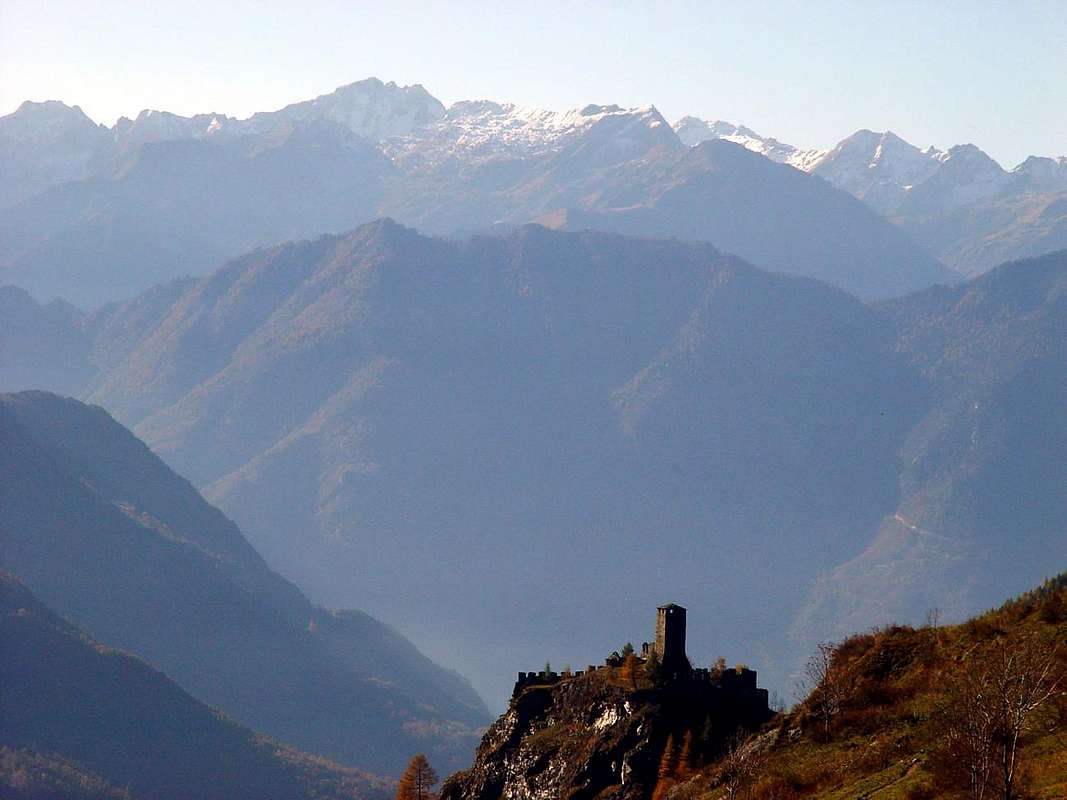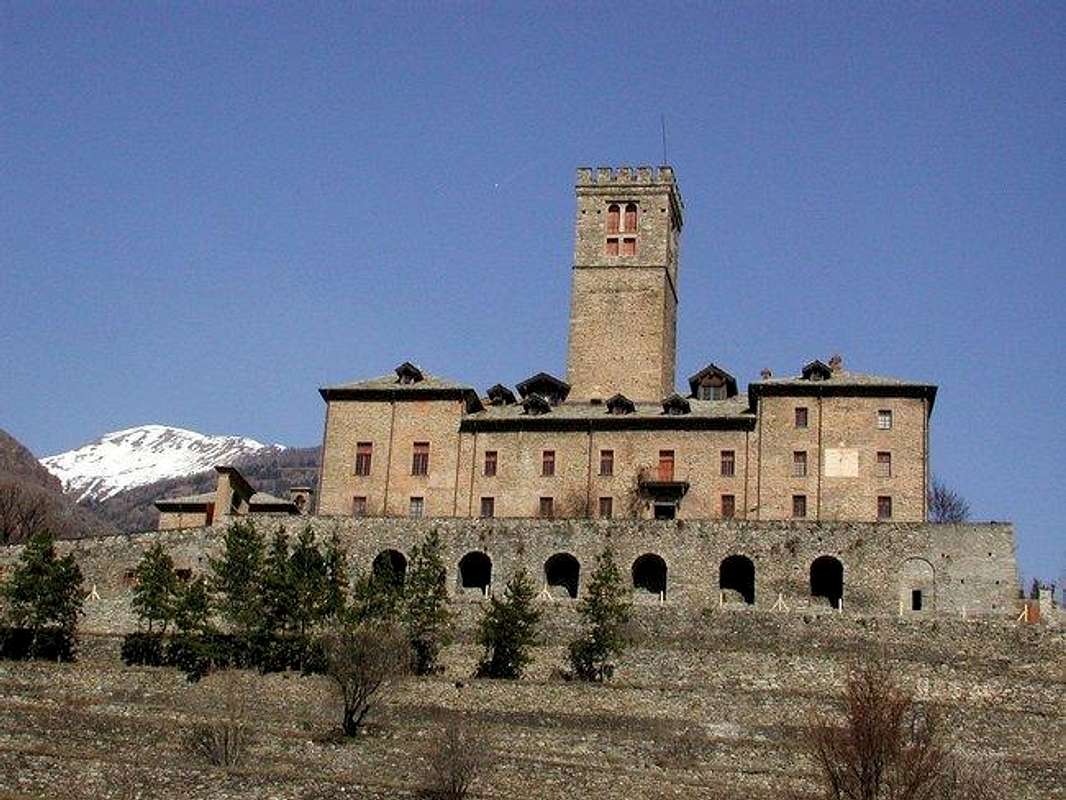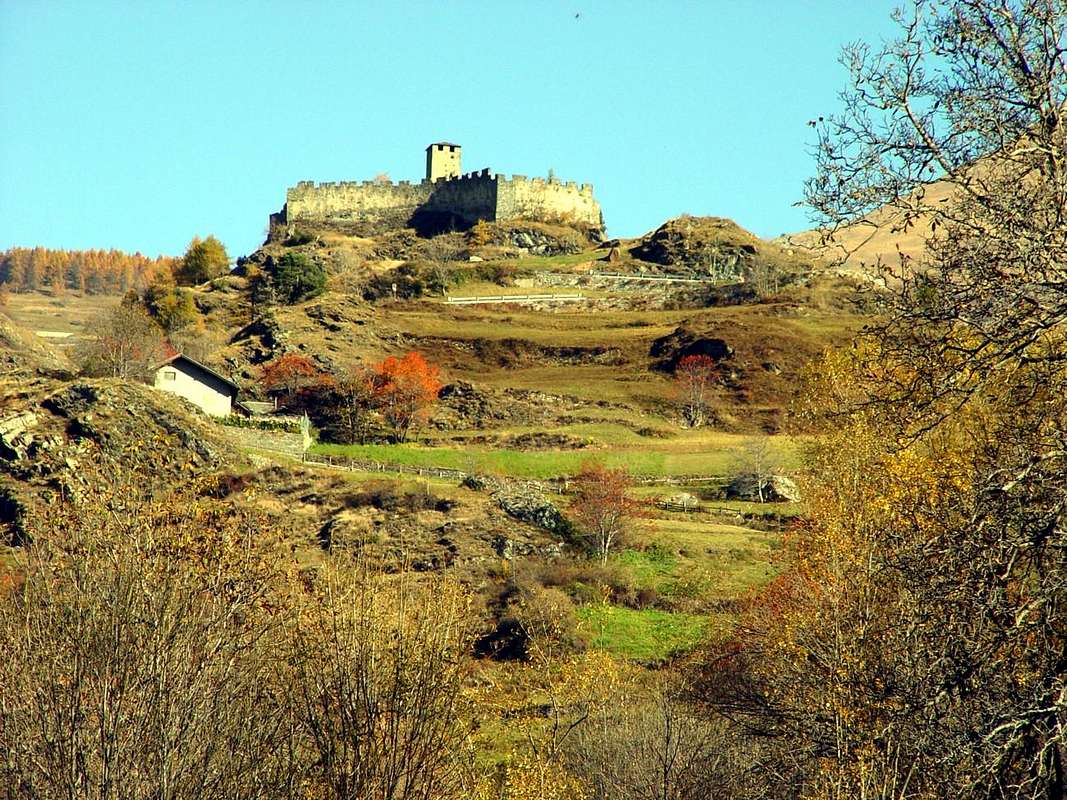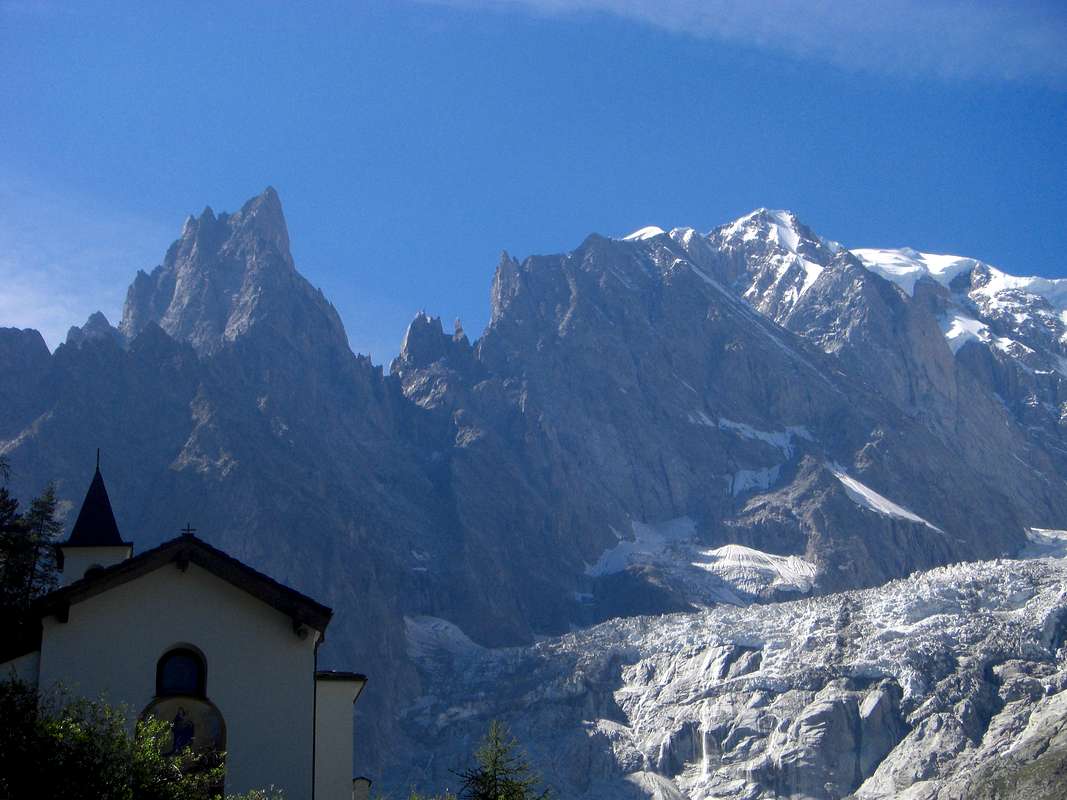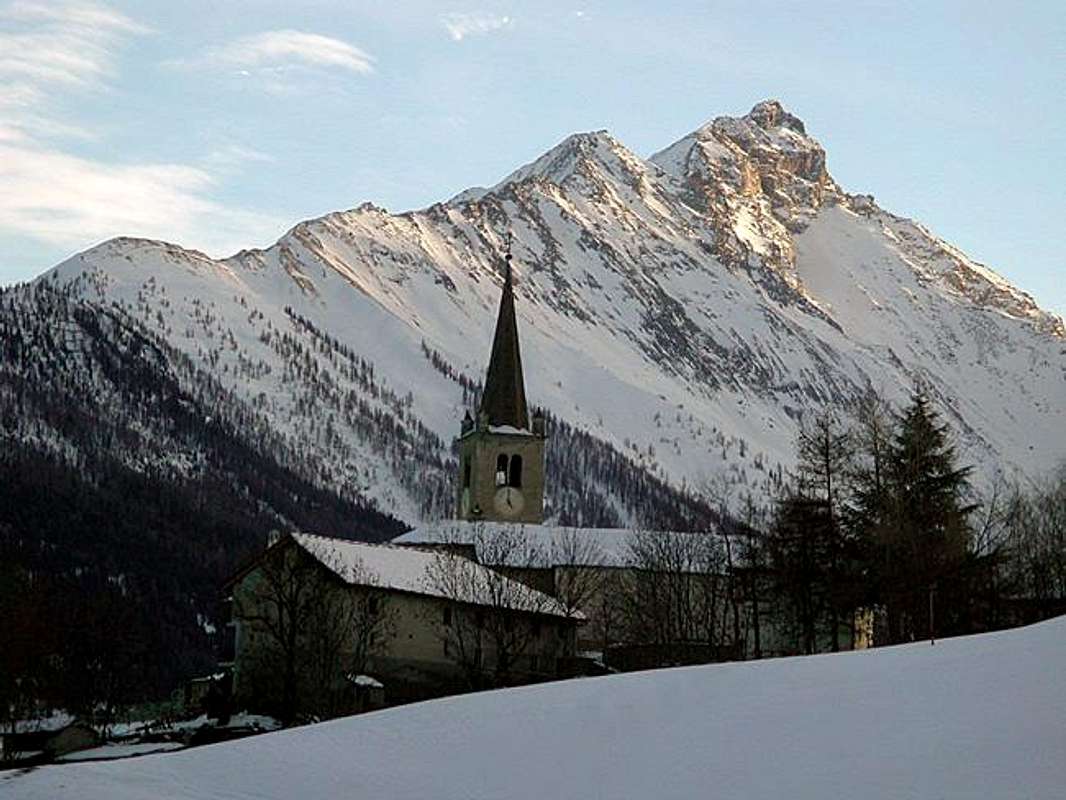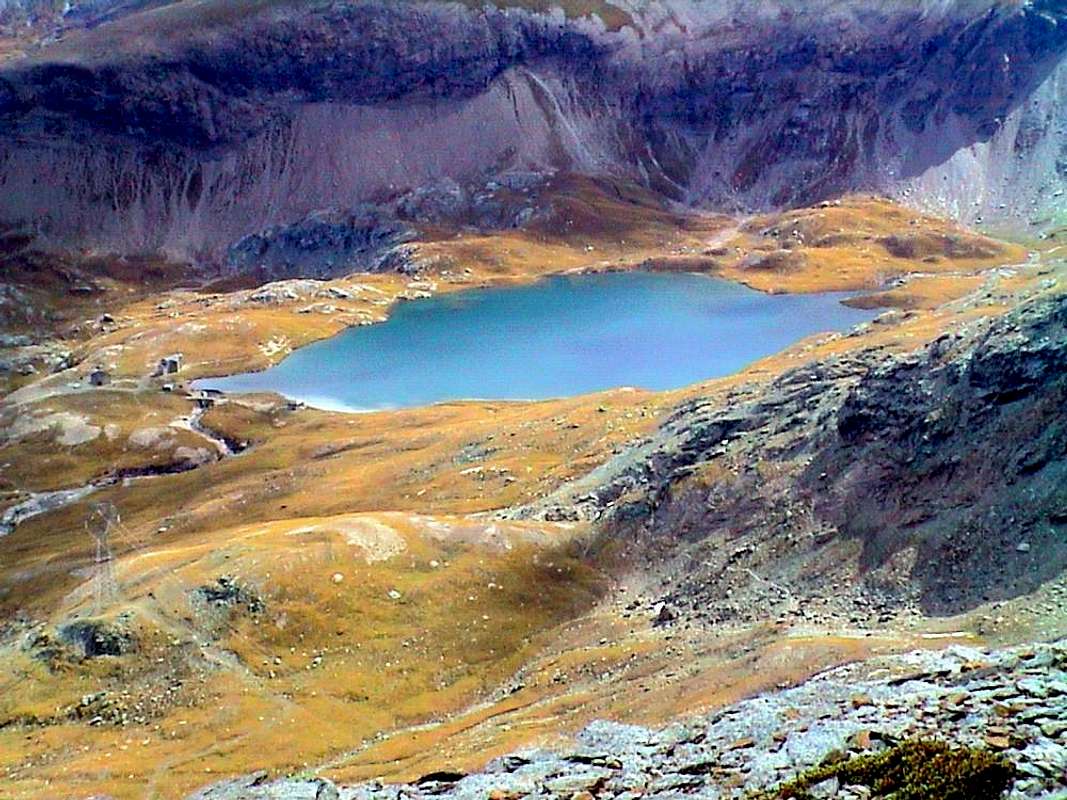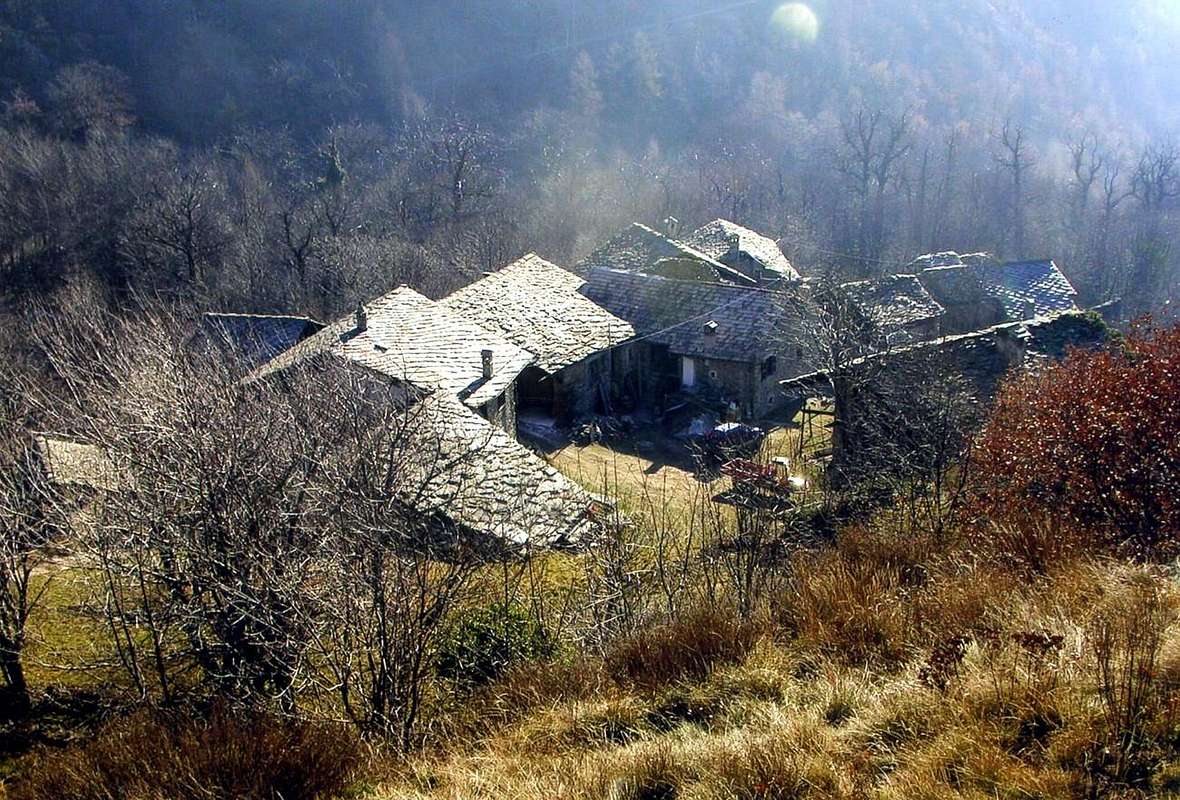Exists. There is a Castle that you have never visited? It exists, and even a Church or a Votive Chapel. They may have Steeples or Towers, or not. But always express a momentum towards Heaven. How Mountains. Otherwise retiring in deep meditation or in a sanctuary, over the top, disappearing from view of the world by taking refuge in a hermitage, as was quite fashionable in Aosta Valley in past centuries. A cave, a cavern even a hovel far from that which even then was considered as the
Esiste una Montagna che pensi non salirai mai più? Esiste. Un Castello che non avete mai visitato? Esiste, ed anche una Chiesa od una Cappella votiva. Posson avere Torri o Campanili, oppur no. Ma esprimono sempre uno slancio verso il Cielo. Come le Montagne. Altrimenti ritirandosi in profonda meditazione in un Santuario od, esageratamente, scomparendo dalla vista del Mondo rifugiandosi in un Eremitaggio, come andava alquanto di moda in Valle di Aosta nei Secoli passati. Una caverna, una spelonca, un miserevole tugurio lontani da quella che già allora era considerata come la
"Civiltà". Tutte insieme queste cose, questi aneliti dell'Anima, lo contemplano e lo sfidano ...
"Aiguilles, Churches & Bell Towers ..."
by emilius, Camillo Roberto Ferronato & Maria Grazia Schiapparelli
In this first page we proceed backward: we present a "Résumé".
Yes, because the scope is so vast, so widened Space that we think make you do a small Tour, a tiny Trip of a week going to visit a lot of what has existed in the Time dilatated and enlarged up to 2000/3000 Years ago, and if we're lucky with the procurement of material, even up to 5/6000. Staying connected to the world of the mountain with its ancient traditions. Along an old track even if only with maybe only a few small walk or short hike. Aimlessly and discovering from time to time what is special, sometimes forgotten or fell into oblivion, and therefore important in our wanderings. But if not an end, because there is at least a starting point we have during this trip that lasts a week exploring the valleys and valleys, villages, pastures and, why not, even the most populated centers, including the City of Aosta. With its history
"modern" which begins in 25 BC with the founding of the Roman
"Augusta Praetoria Salassorum", over the ancient
Bourg of Cordelia or Cordelia, built in 1158 a. C. by Cordelo and then improved by Pico. The
"Rome of the Alps" built by the Consuls of the Praetorians Marcus Valerius Messala and Aulus Taerentius Varro Murena already with walls of 23 BC, while the following year it was erected the
"Arch of Augustus" in honor of the Emperor Gaius Octavian Caesar Augustus in order to celebrate the victory over warlike and indomitable people Celtic-Ligurian Salassi reducing it to slavery with 36,000 prisoners (says the Historian Strabo) and thus releasing the
"Gauls Via" towards the
"Alpes Graias et Poeninas".
![]() "Before XIV° Century ... Sarriod de la Tour Lords Castle",
"Before XIV° Century ... Sarriod de la Tour Lords Castle",
by OswBut it is also a journey to the "Christianity", which starts in Aosta Valley through the Evangelization that took place in Centuries III° and IV° and that despite the passage of the Goths in 410 AD and the Lombards after the fall of the Roman Empire in 476 AD, with the Burgundians and Charlemagne until 888 AD and the third Kingdom of Burgundy has left many traces of this. While the later Middle Ages, stands out in its traces with Towers and Castles. But the Valley also it offers the remains of the
Neolithic with the
Necropolis and the
Dolmen Vollein (891m), above the little Town of Nus, and special
"sitting" burials 5/6000 years ago found in Champagnole at Châtel d'Argent nearby Villeneuve Common. Short trips, almost walks, to reach the places where he often arrives by car but, if desired, offer an opportunity to make a short way through comfortable and marked trails, often inter-related, and therefore with the possibility of combining the itineraries stringing together a series of consecutive visits. Experience already carried out for many years, but where the primary objective was mountaineering and therefore very limited attention and their stops against this speech; greater attention developed in the last ten years and that resumed Sunday, May 10th with a decision to revisit almost completely what had previously been seen so fleeting. Starting from the City of Aosta for onward transit to the neighbors of Sarre, St. Pierre, St. Nicolas, Villeneuve, Aymavilles, Gressan, Jovençan and Charvensod Municipalities in a Tour which will give you progressively report. This way you think to continue to proceed without a sequence previously planned and established. However, with respect to the writing of the pages, obviously you have to have recourse to a more systematic discussion that we decided to split, in addition to this, in three more pages concerning:
Upper Valley or Valdigne, City of Aosta and surroundings with Gran San Bernardo Valpelline or
"binding" with the South side of
Val Cogne. Also alternatively
Valsavarenche Rhêmes and then finish with the
Lower Valley to Pont St. Martin Commune. Regarding the side valleys than the Baltea main Stream, will be included in the relative page considering the proximity to the respective area, but especially taking into account the passage of the water basin. So this page consists of a general
"Ouverture" towards this
Trip Report, more specifically in three next.
![]() "Verrès Challant Lords & Savoy's Castle with Mont Avìc Group"
"Verrès Challant Lords & Savoy's Castle with Mont Avìc Group"
by andreaperino
In questa prima pagina procediamo a rovescio: presentiamo un "Résumé". Sì, perché il campo di azione risulta così vasto, così allargato nello Spazio che pensiamo di farvi fare un piccolo Tour, un Giretto d'una settimana andando a visitare molto di quello che é esistito nel Tempo dilatatato ed espanso sino a 2000/3000 Anni orsono e, se abbiamo fortuna con il reperimento del materiale, anche fino a 5/6000. Sempre restando legati al Mondo della montagna con le sue tradizioni millenarie. Percorrendo un'antica traccia magari soltanto con qualche piccola passeggiata o breve escursione. Senza una meta precisa e scoprendo di volta in volta ciò che é particolare, a volte dimenticato od obliato, e per ciò importante nel nostro vagabondaggio. Però se non un fine, perché non esiste, almeno un punto di partenza dobbiamo averlo durante questo viaggio che dura una settimana esplorando valli e vallate, villaggi, alpeggi e, perché no, anche i centri maggiormente abitati, compresa la Città di Aosta. Con la sua storia
"moderna" che inizia nel 25 avanti Cristo con la fondazione romana di
"Augusta Praetoria Salassorum", sopra l'antica
Città di Cordelia o Cordella, costruita nel 1158 a. C. da Cordelo e poi migliorata da Pico. La
"Roma delle Alpi costruita dai Consoli dei Pretoriani Marco Valerio Messala ed Aulo Terenzio Varrone Murena già con la cinta muraria del 23 a.C., mentre nello anno successivo veniva eretto l'
"Arco di Augusto" in onore dell'Imperatore Caio Ottaviano Cesare Augusto, onde celebrare la vittoria sul bellicoso ed indomito popolo celto-ligure dei Salassi riducendolo in schiavitù con 36.000 prigionieri (racconta lo Storico Strabone) e così liberando la
"Via delle Gallie" verso l'
"Alpes Graias et Poeninas".
![]()
"Ville Dessous 1867 Chapel, between Villeneuve & Introd",
by Osw
Ma un viaggio anche verso la "Cristianità", che in Valle di Aosta inizia tramite l'Evangelizzazione avvenuta nei Secoli III° e IV° e che, nonostante il passaggio dei Goti nel 410 d.C e dei Longobardi dopo la caduta dello Impero Romano nel 476 d.C, con i Borgognoni e Carlo Magno fino al 888 d.C. ed il terzo Regno di Borgogna ha lasciato ampie sue tracce. Mentre il tardo Medio Evo risalta nelle sue vestigia con Torri e Castelli. Ma la Valle propone anche resti del
Neolitico con la
Necropoli e Dolmen di Vollein (891 m), sopra il Comune di Nus, e le particolari sepolture
"sedute" di 5/6000 anni orsono ritrovate a Champagnole presso il Châtel d'Argent a Villeneuve. Piccole escursioni, quasi passeggiate, per raggiungere dei luoghi dove spesso si arriva anche tramite l'auto ma che, volendo, offron occasione per effettuare una breve gita tramite comodi e segnalati sentieri, molto spesso tra di lor collegati e quindi con la possibilità di abbinare gli itinerari inanellando una serie di visite consecutive. Un'esperienza già effettuata da molti anni, dove però l'obiettivo primario era alpinistico e quindi limitava molto le attenzioni e relative soste nei confronti di questo discorso; un'attenzione maggiore sviluppata negli ultimi dieci anni e ripresa domenica 10 Maggio con decisione di rivisitare in modo quasi completo ciò che era stato precedentemente visto in modo fuggevole. Partendo dal Comune di Aosta per poi transitare verso i vicini di Sarre, St. Pierre, St. Nicolas, Villeneuve, Aymavilles, Gressan, Jovençan e Charvensod in un Tour del quale vi daremo progressivamente rapporto. In questo modo si pensa di continuare a procedere, senza sequenza precedentemente programmata e stabilita; per quanto concerne invece la stesura delle pagine, evidentemente si deve fare ricorso ad un discorso più sistematico che abbiam pensato di suddividere, oltre a questa, in altre tre pagine successive concernenti:
Alta Valle o Valdigne, Città di Aosta e dintorni con Gran San Bernardo e Valpelline, oppure
"legandosi" con il versante Meridionale
Val di Cogne. Oppure in alternativa
Valsavarenche e Rhêmes, per poi terminare con la
Bassa Valle fino a Pont St. Martin. Per quanto concerne le vallate laterali rispetto alla Dora Baltea, saranno inserite nella relativa pagina prendendo in considerazione la vicinanza alla rispettiva area, ma soprattutto tenendo conto dello scorrere idrografico delle acque.
![]() "Graines Lords Challants Castle with Eastern Graian Alps"
"Graines Lords Challants Castle with Eastern Graian Alps"
by Emilio Bertona aka emilius
Castles Castelli & Châteaux
![]() "Sarre Lords Bard Castle & Becca France"
"Sarre Lords Bard Castle & Becca France"
by Maria Grazia Schiapparelli
There are many Castles that meet climbing the Aosta Valley coming from Piedmont Region and along the railway, motorway or the state road the valley next to the course of the Dora Baltea and up to Courmayeur Common at the foot of Mont Blanc Chain. They are all visible, as visible are the
"Watchtowers" that were used to bind the other to a common signaling through the fires for possible inputs of incoming enemies. Among these highlights the grim Forteress of Bard at Hône Municipalities that stopped the advance of Napoleon in the Italian Campaign of May 1800. But throughout the Valley, often subject to invasions with the passage in the Centuries of the Armed from the Romans and the Carthaginians by Hannibal, owns this reporting system defense, which, in addition to the central axis, branches in various side valleys of the reporting population through turrets and fortified houses with links to the respective valleys in front. Among the most important castles we mention in order: Verrès, Issogne, Ussel over Pontey Common, Fénis, Quart above Villair Fraction,
"Passerin d'Entrèves" at Saint Christophe,
"Duca degli Abruzzi" above Aosta, Sarre and Sarriod de la Tour both in Sarre Common, Aymavilles, Châtel Argent over Villeneuve, Introd. And many others, already in semi ruins, such as the very wild of Montmayeur at the entrance of Valgrisenche.
![]() "Saint Marcel Torre di Guardia or Watchtower"
"Saint Marcel Torre di Guardia or Watchtower"
by Emilio Bertona aka emilius
Molti sono i Castelli che incontriamo salendo la Valle di Aosta arrivando dal Piemonte percorrendo con la Ferrovia, l'Autostrada o la Strada Statale il fondovalle a fianco del corso della Dora e fino a Courmayeur ai piedi del Monte Bianco. Sono tutti visibili, come visibili sono le
"Torri di Guardia" che servivano a legare un comune all'altro per le segnalazione tramite fuochi circa eventuali ingressi di nemici in arrivo. Tra queste s'evidenzia l'arcigno Forte di Bard presso Hône che fermò nel 1800 l'avanzata di Napoleone nella Campagna d'Italia. Ma tutta la Valle, soggetta spesso ad invasioni con il passaggio di Armate nei Secoli a partire dai Romani e dai Cartaginesi di Annibale, possiede questo sistema di segnalazione difensivo, che, oltre all'asse centrale, si dirama nelle varie vallate laterali tramite torrette di segnalzione e caseforti con collegamenti alle rispettive valli frontali. Tra i castelli più importanti segnaliamo in ordine: Verrès, Issogne, Ussel a Pontey, Fénis, Quart,
"Passerin d'Entrèves" a Saint Christophe,
"Duca degli Abruzzi" al di sopra di Aosta, Sarre e Sarriod de la Tour, Aymavilles, Châtel Argent a Villeneuve, Introd. E molti altri, ormai già in semi rovina, come quello di Montmayeur all'ingresso della Valgrisa.
![]() "Graines Lords Challants Castle towards Frudière Vallon"
"Graines Lords Challants Castle towards Frudière Vallon"
by Emilio Bertona aka emilius
Churches & Votive Chapels
![]() "Notre Dame de la Guérison, Aiguille Noire & Mont Blanc"
"Notre Dame de la Guérison, Aiguille Noire & Mont Blanc"
by Corvus aka Gabriele Corvini
It does not exist in the Aosta Valley Hamlet, even the smallest, where not exists his Church with its Bell Tower. Indeed until the beginning of '900 was made almost a competition for the most beautiful or the highest. And after the First World War, perhaps by merging the guns to build the Bells as those of Rhêmes Notre Dame, however, already built in 1800, it is the most ringing, if not noisy, of throughout the Valley. But even going up to the mountain Pastures found Chapels Votive almost everywhere, as well as the inevitable wooden Cross, for drive out the devil, in front of each of them. What a testimony to the great
"Religiosity" existing. At least until last Century ...
"Saint Nicolas Church & Bell Tower below Punta Leissé or Leysser"
by emilius, Maria Grazia Schiapparelli, livioz & Antonio
Non esiste in Val d'Aosta Paese o Villaggio, anche il più minuscolo, che non abbia la sua Chiesa col suo Campanile. Anzi fino agli inizi del '900 si effettuava quasi una gara per aver quella più bella oppure il più alto. E dopo la Prima Guerra Mondiale, magari fondendo i cannoni per costruire le Campane come quelle di Rhêmes Notre Dame che, però già costruite nel 1800, risultano le più squillanti, per non dir rumorose, di tutta la Valle. Ma anche salendo verso gli Alpeggi trovate Cappelle Votive un pò ovunque, nonché l'immancabile Croce in legno, atta a scacciare il Diavolo, davanti ad ognun d'essi. Ciò a testimonianza della grande
"Religiosità" esistente. Almen sin allo scorso Secolo ...
![]()
Saint Nicholas Church & Punta del Ran from North,
by Maria Grazia Schiapparelli
Sanctuaries Shrines & Hermitages
![]() "Miserin Sanctuary Notre-Dame-des-Neiges from Tour Ponton"
"Miserin Sanctuary Notre-Dame-des-Neiges from Tour Ponton"
by emilius
The same Religiosity that has raised Convents, Sanctuaries and Hermitages scattered in the mountains. Maybe in the old days where there was only a small Votive Chapel or a tiny statue of the Madonna, as the Sanctuary of the
"Madonna della Guardia" between Pont Saint Martin and Perloz, Re Tempio (King Temple) or
"Our Lady of the Visitation" above Pont-Bozet,
"Notre -Dame-des-Neiges" Lake Miserin Champorcher, to Machaby above Arnad or Arnaz, to Plout of Saint Marcel,
"Madonna of the Heights" to Cuney in the Valley of Saint-Barthélemy,
San Grato at Pila and the famous Piccolo San Bernardo or
"Alpis Graia", not to mention the even more ancient-Hospice-Convent of the Monks of the Gran San Bernardo on the remains of the
"Pen Alpe or Poenina" and
"Notre Dame de la Guérison" immediately after Courmayeur and at the gates of Val Veny. Or a cave in the rock which hosted the extravagant Hermits like Saint Julien or Santa Giuliana (Martyr Roman or neighbors envious, while the History speaks of a second Hermit came here in 1777 and that, in reality, was a guy named Champier Jean-Pierre de Mathieu original and originary from the Ollomont Valpelline) in Fénis with its inevitable
Legend.
![]() "Machaby Village neighbor the Sanctuary Madonna della Neve"
"Machaby Village neighbor the Sanctuary Madonna della Neve"
by Camillo Roberto Ferronato
Stessa Religiosità che ha fatto sorgere Conventi, Santuari ed Eremitaggi sparsi tra le montagne. Magari laddove in tempi andati esisteva esclusivamente una Cappelletta Votiva od una statuetta della Madonna, come al Santuario della
"Madonna della Guardia" tra Pont Saint Martin e Perloz, Re Tempio o
"Nostra Signora della Visitazione" sopra Pont-Bozet,
"Notre-Dame-des-Neiges" al Lago Miserin a Champorcher, a Machaby sopra Arnad o Arnaz, a Plout di Saint Marcel,
"Madonna delle Altezze" al Cuney in Valle di Saint Barthélemy, a
"San Grato" presso Pila nonché al famoso Piccolo San Bernardo o
"Alpis Graia", per non parlar dell'ancor più antico Convento-Ricovero dei Monaci del Gran San Bernardo sui resti della
"Alpe di Pen o Poenina" ed a Notre Dame de la Guèrison dopo Courmayeur e subito alle porte della Val Veny. Oppure una grotta nella roccia accogliente gli stravaganti Eremiti tipo Saint Julien o Santa Giuliana (Martire dei Romani o di compaesani invidiosi, mentre la Storia parla d'un secondo Eremita quivi giunto ed ospitato nel 1777 e che, in realtà, era un tizio originale di nome Champier Jean-Mathieur de Pierre originario d'Ollomont in Valpelline) al di sopra di Fénis con immancabile relativa
Leggenda.
"St. Grat Shrine, Plout Sanctuary, Cuney Sanctuary below Becca del Merlo and Ermite du Cuney & Saint Julien Hermitage under Mont St. Julien"
by emilius, Camillo Roberto Ferronato, p-mike & Osw
